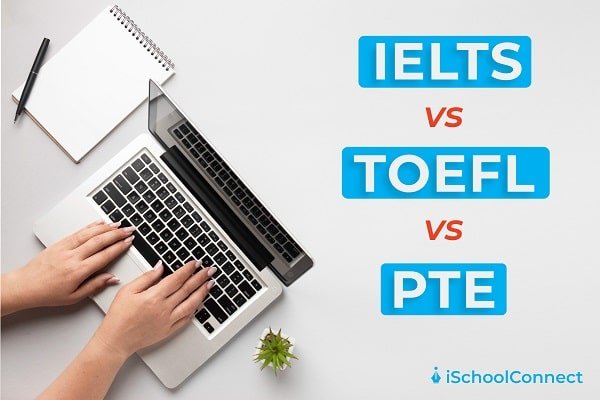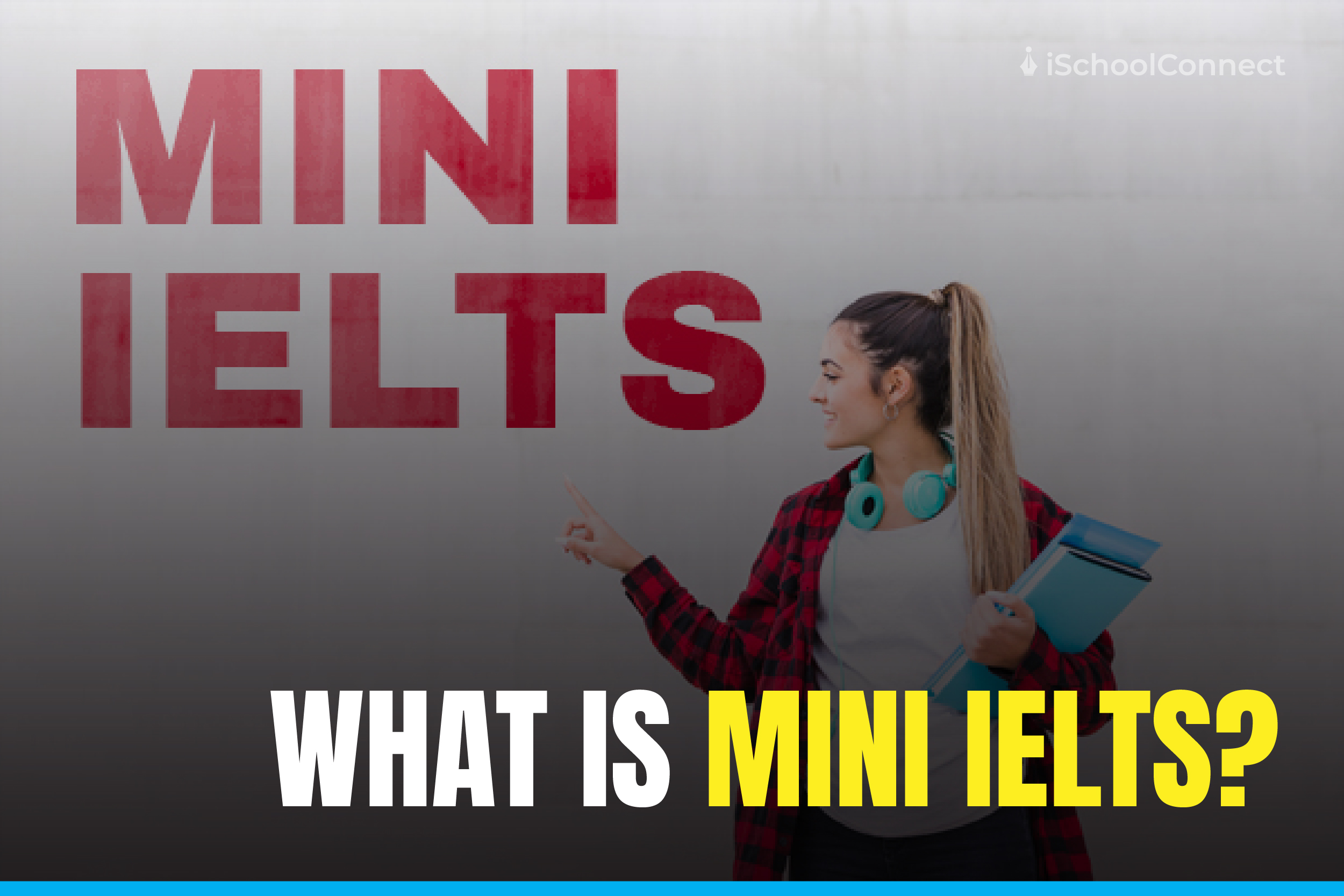Table of Contents
- What is IELTS?
- What is TOEFL?
- What is PTE?
- IELTS vs TOEFL vs PTE: Exam Structure
- IELTS vs TOEFL vs PTE: A Comparison of Reading, Listening, Speaking, and Writing Sections
- Reading Section: IELTS vs TOEFL vs PTE
- IELTS Reading Section
- TOEFL Reading Section
- PTE Reading Section
- Listening Section: IELTS vs TOEFL vs PTE
- IELTS Listening Section
- TOEFL Listening Section
- PTE Listening Section
- Speaking Section: IELTS vs TOEFL vs PTE
- IELTS Speaking Section
- TOEFL Speaking Section
- PTE Speaking Section
- Writing Section: IELTS vs TOEFL vs PTE
- IELTS Writing Section
- TOEFL Writing Section
- PTE Writing Section
- TOEFL vs IELTS vs PTE: What’s the Exam Fee in India?
- PTE IELTS, TOEFL: Results Comparison
- IELTS vs TOEFL vs PTE Comparison: Scoring Systems
- IELTS vs TOEFL vs PTE: Which One is Accepted More?
- IELTS vs TOEFL vs PTE: Which One is Easier?
- Key Takeaways
- FAQs
When planning to study, work, or immigrate to an English-speaking country, proving your English proficiency is essential. IELTS, TOEFL, and PTE are three popular exams, each designed to assess your language skills in reading, writing, listening, and speaking. Though these tests serve a similar purpose, they differ in format, scoring, and regional preferences. Understanding the difference between IELTS vs TOEFL vs PTE can help you choose the best exam for your goals and get one step closer to your dream destination.
When considering English proficiency exams, IELTS, TOEFL, and PTE are the primary options for students, professionals, and migrants. IELTS is the most widely recognized, with a strong global presence and acceptance by over 12,000 organizations across 140 countries. TOEFL follows closely, especially popular in the United States. PTE, while newer, is gaining acceptance in English-speaking countries.
What is IELTS?
The International English Language Testing System (IELTS) is an English proficiency test widely recognized by universities and organizations globally. Managed by the British Council, IDP, and Cambridge English, IELTS tests candidates’ listening, reading, writing, and speaking skills.
What is TOEFL?
The Test of English as a Foreign Language (TOEFL), conducted by ETS, is particularly popular for students applying to institutions in the United States. It is accepted by more than 14,000 organizations across 200+ countries and assesses listening, reading, writing, and speaking skills.
What is PTE?
The PTE full form is Pearson Test of English Academic, a fully computer-based English language exam known for its quick scoring. Gaining popularity, the PTE is accepted by over 3,500 institutions worldwide, including in Australia, Canada, the UK, and the U.S. The exam duration is about 2 hours and 15 minutes, and the PTE exam fee is Rs. 17,000 in India across major cities.
The table below outlines the main parameters of each test to help you understand the difference between IELTS vs TOEFL vs PTE and choose the right one based on format, scoring, and country-specific preferences.
Parameters | IELTS | TOEFL | PTE |
Full form | International English Language Testing System | Test of English as a Foreign Language | Pearson Test of English |
Definition | A globally recognized test of English proficiency for academic and immigration purposes. | A test that measures English proficiency, mostly used for academic purposes. | A computer-based English language proficiency test for non-native speakers, focusing on academic English. |
Exam Duration | 2 hours 45 minutes | iBT: 2-2.5 hours, PBT: 2.5 hours | 2 hours 15 minutes |
Exam Pattern | 4 sections: Listening, Reading, Writing, Speaking | 4 sections: Reading, Listening, Speaking, Writing | 3 sections: Listening, Reading, Writing & Speaking |
Types of test | Academic, General Training | iBT, PBT | Academic |
Mode of Examination | Paper-based or computer-based | Computer-based | Computer-based |
Score Range | 1-9 | 0-120 | 10-90 |
Validity | 2 years | 2 years | 2 years |
Exam Fees | 17,000 INR | 16,900 INR | 17,000 INR |
Difficulty Level | Moderate to High, may vary due to human assessment in Speaking and Writing | Moderate to High, multiple-choice format makes it more structured | Moderate to high, fast-paced computer-based scoring with no waiting time. |
Meant For | Students, professionals, and migrants applying to English-speaking countries or jobs needing English skills | Primarily for students applying to universities, especially in the US | Primarily for students applying for higher studies or immigration to English-speaking countries |
Acceptability in Different Countries | Accepted globally, especially in the UK, Australia, Canada, New Zealand, USA, and Europe | Accepted in over 160 countries, especially popular in the US; over 12,500 institutions recognize it | Increasing acceptance in countries like Australia, Canada, New Zealand, UK, and the USA |
Result time | 13 days (paper-based), 3-5 days (computer-based) | 6 days (iBT), 11-13 days (PBT) | 2-5 days |
IELTS vs TOEFL vs PTE: Exam Structure
The IELTS, TOEFL, and PTE exams all assess four key language skills: Reading, Listening, Writing, and Speaking. While IELTS and TOEFL divide these into four separate sections, PTE combines the Speaking and Writing sections into a single component, creating a total of three sections. Exam durations vary: IELTS lasts 2 hours and 45 minutes, while recent changes have adjusted the time for TOEFL and PTE. Here’s a breakdown of each exam’s structure to help you understand the difference between IELTS vs TOEFL vs PTE and choose the best option for your needs.
Exam | Test Duration | Mode of Exam | Format |
IELTS | 2 hours 45 minutes | Paper-based and Computer-based | Listening, Reading, Writing, Speaking |
TOEFL | 2-2.5 hours | Internet-based Test (iBT) and Paper-delivered Test (PBT) | Reading, Listening, Speaking, Writing |
PTE | 2 hours 15 minutes | Computer-based | Speaking & Writing, Reading, Listening |
Choosing the right one depends on your target country and institution preferences, as well as the format that best suits your preparation style.
Get More Details: IOT IELTS in 2025: Key Features & Preparation Resources
IELTS vs TOEFL vs PTE: A Comparison of Reading, Listening, Speaking, and Writing Sections
When it comes to English proficiency tests like IELTS, TOEFL, and PTE, each exam has its own unique format and structure. If you’re preparing for one of these tests, understanding the difference between IELTS vs TOEFL vs PTE is essential. Each test evaluates your skills in Reading, Listening, Speaking, and Writing differently. Here’s a detailed comparison to help you decide which test best suits your needs.
Reading Section: IELTS vs TOEFL vs PTE
IELTS Reading Section
- The IELTS reading section consists of 3 passages with a total of 40 questions.
- Candidates are allotted 60 minutes to complete the section.
- The questions may include multiple-choice, matching, diagram labeling, and true/false questions.
- The distribution of questions across different tasks is not fixed, offering some variety in question types.
TOEFL Reading Section
- The TOEFL reading section features 3-4 passages, each with 10 questions.
- The time for the reading section can range from 54 to 72 minutes, depending on the number of passages.
- Topics often involve compare/contrast or cause-effect relationships.
- The score for this section ranges from 0 to 30.
PTE Reading Section
- In the PTE reading section, candidates read through passages and then answer questions.
- The section lasts between 32 to 40 minutes.
- Tasks include fill-in-the-blank questions, reordering paragraphs, and multiple-choice questions.
Listening Section: IELTS vs TOEFL vs PTE
IELTS Listening Section
- The IELTS listening section consists of 40 questions spread across 4 tasks, to be completed in 30 minutes.
- Candidates listen to 4 recordings that are played only once, and these recordings feature various accents of native speakers.
- Tasks include multiple-choice, matching, map labeling, note completion, and short-answer questions.
TOEFL Listening Section
- The TOEFL listening section includes 3-4 lectures and classroom discussions, along with 2-3 daily-life conversations.
- Each lecture lasts 3-5 minutes and is followed by 6 questions.
- The listening section features a variety of North American native speaker accents.
PTE Listening Section
- The PTE listening section lasts between 45 to 57 minutes.
- It includes tasks like summarizing written text, filling in blanks, selecting missing words, and identifying incorrect phrases.
Speaking Section: IELTS vs TOEFL vs PTE
IELTS Speaking Section
- The speaking test is a face-to-face interview with an examiner lasting 11-14 minutes.
- It consists of 3 parts:
- An introduction/interview (4-5 minutes).
- A task where candidates speak on a given topic for 1-2 minutes (after 1 minute of preparation).
- A discussion on the topic from the second part in a more abstract way (4-5 minutes).
- In some cases, the speaking test may be held on a different day from the other sections.
TOEFL Speaking Section
- The TOEFL speaking section consists of 4 tasks:
- An independent task where you express your opinion on a familiar topic (30 seconds of preparation).
- Three integrated tasks based on reading and listening, each requiring 1 minute of preparation.
- The total time for this section is 17 minutes, and scores are given on a scale of 0-30.
PTE Speaking Section
- In PTE, the speaking and writing sections are combined, and the speaking portion includes tasks such as reading aloud, repeating sentences, retelling lectures, and answering short questions.
- Candidates also write an essay (200-300 words) in 20 minutes.
Writing Section: IELTS vs TOEFL vs PTE
IELTS Writing Section
- The IELTS writing test is divided into two tasks:
- Task 1: Candidates must describe visual information (e.g., graphs or pie charts) in at least 150 words.
- Task 2: Candidates must write an essay in response to a question, elaborating on a topic or argument in at least 250 words.
- The total time for this section is 60 minutes.
TOEFL Writing Section
- The TOEFL writing section consists of two tasks:
- Task 1: An integrated task where you read and listen to content before writing a response (20 minutes).
- Task 2: An independent task where you support an opinion on a given topic (30 minutes).
- The total time for the writing section is 50 minutes, and scores are given on a scale of 0-30.
PTE Writing Section
- The PTE writing section, combined with speaking, lasts between 77 to 93 minutes.
- Tasks include reading aloud, repeating sentences, retelling lectures, answering short questions, and writing an essay of 200-300 words in 20 minutes.
Read More: 8 TOEFL essay topics to prepare for the TOEFL exam
Find Out More: Everything about the preparation for PET exam
TOEFL vs IELTS vs PTE: What’s the Exam Fee in India?
When comparing the difference between IELTS vs TOEFL vs PTE, exam fees for Indian candidates are quite similar, generally around Rs 17,000. Below is a comparison of the exam fees:
Exam | Exam Fee in India |
IELTS | Rs 17,000 |
TOEFL | Rs 16,900 |
PTE | Rs 17,000 |
PTE IELTS, TOEFL: Results Comparison
When considering the difference between IELTS vs TOEFL vs PTE, it’s important to note that the release time for score reports varies across the three exams. Here’s a breakdown of when you can expect your results:
Exam | Result Release Time |
IELTS | 13 days (paper-based), 3-5 days (computer-based) |
TOEFL | 6 days (iBT), 11-13 days (PBT) |
PTE | 2-5 days |
IELTS vs TOEFL vs PTE Comparison: Scoring Systems
Each of the three major English proficiency exams—IELTS, TOEFL, and PTE—uses a distinct scoring system. Here’s how they compare:
IELTS Scoring
- Scoring Range: 0-9 bands for each section (Listening, Reading, Writing, Speaking) and overall score.
- Proficiency Levels: The higher the band score, the better the proficiency.
IELTS Score | Proficiency Level |
9 | Expert |
8.5 | Very Good |
8 | Very Good |
7.5 | Good |
7 | Good |
6.5 | Competent |
6 | Competent |
5.5 | Modest |
5 | Modest |
4.5 | Limited |
0-4 | Extremely Limited |
Uncover More: IELTS band required for Australia- A Guide for 2025
TOEFL Scoring
- Scoring Range: 0-30 per section (Listening, Reading, Writing, Speaking), with a total of up to 120 points.
- Proficiency Levels: A higher score indicates better proficiency in English.
TOEFL iBT Score | Proficiency Level |
118-120 | Expert |
115-117 | Very Good |
110-114 | Very Good |
102-109 | Good |
94-101 | Good |
79-93 | Competent |
60-78 | Competent |
46-59 | Modest |
35-45 | Modest |
32-34 | Limited |
0-31 | Extremely Limited |
Explore Further: TOEFL Score, What is a good TOEFL score?
PTE Scoring
- Scoring Range: 10-90, based on the Global Scale of English, for the overall test.
- Proficiency Levels: PTE also provides scores for Communicative and Enabling Skills.
PTE Score | Proficiency Level |
89-90 | Expert |
83-85 | Very Good |
78-82 | Very Good |
73-77 | Good |
64-72 | Good |
58-63 | Competent |
50-57 | Competent |
42-49 | Modest |
35-41 | Modest |
30-34 | Limited |
0-30 | Extremely Limited |
This TOEFL vs PTE score comparison shows that while all three tests assess similar language skills, they use different scales to evaluate proficiency, so choosing the one that aligns best with your goals is essential.
IELTS vs TOEFL vs PTE: Which One is Accepted More?
Determining which exam is more widely accepted globally can be difficult, as all three – IELTS, TOEFL, and PTE – are recognized by thousands of institutions worldwide. However, each test has specific advantages depending on the region and the institution’s requirements for English proficiency.
TOEFL: Primarily preferred by universities in the United States, TOEFL is widely accepted by American institutions as the standard for evaluating English proficiency among international applicants.
IELTS: With its extensive global presence, IELTS is the preferred exam in the United Kingdom, Australia, Canada, and Germany. IELTS is recognized by over 12,000 organizations worldwide and is often the go-to exam for these countries.
- PTE: Though a relatively newer entrant, PTE Exam has gained significant traction in Australia and Europe, where many universities and institutions favor it for its fully computer-based format and quick results.
Thus, the most widely accepted exam depends on your target country and the specific requirements of your chosen institution. Understanding the difference between IELTS vs TOEFL vs PTE will help you choose the right one for your study, work, or immigration goals.
Discover More: TOEFL Accepted Universities in Canada
IELTS vs TOEFL vs PTE: Which One is Easier?
Choosing between IELTS, TOEFL, and PTE depends on your strengths and the requirements of the universities you’re applying to. Each test evaluates your reading, writing, listening, and speaking skills, but the difficulty level can vary based on your preferences.
- IELTS: Requires a score of at least 7.0 for most universities.
- TOEFL: Typically, a score above 90 is needed for admission.
- PTE: A score above 60 is generally sufficient for most institutions.
When considering TOEFL vs PTE, which is easier, PTE is often considered more straightforward due to its fully computer-based format and faster results.
Key Takeaways
- All three tests, IELTS, TOEFL, and PTE, are globally recognized, but the preference may vary depending on the country and institution.
- TOEFL is preferred in the US, while IELTS is common in the UK, Australia, and Canada, with PTE gaining popularity in Australia and Europe. When considering IELTS TOEFL, which is easier, it depends on your personal preference and exam comfort.
- Each test has a different format—IELTS and TOEFL are more traditional, while PTE is computer-based, offering faster scoring and a more integrated approach.
- Understanding the difference between IELTS vs TOEFL vs PTE is crucial for choosing the right test based on your personal strengths, preparation style, and the requirements of your desired institutions or immigration authorities.
- Additionally, when comparing IELTS vs TOEFL vs PTE vs Duolingo, it’s important to consider factors such as convenience, cost, and acceptance by your target institutions or visa authorities.
To get a clearer idea, you can read this blog about IELTS vs TOEFL, for a better perspective on the details of these two more widely accepted entrance exams.
FAQs
Ques 1: When should I take an English proficiency test?
Answer 1: It’s best to take your English proficiency test at least a year before your application deadline. This gives you enough time to prepare and meet the requirements for universities, jobs, or immigration to English-speaking countries.
Ques 2: What resources can I refer to when preparing for IELTS?
Answer 2: There are many books and online courses to help you prep for IELTS. The British Council offers a dedicated online course, and you can also explore iSchoolPrep for all your study abroad test resources.
Ques 3: Do I need to take English proficiency tests if I am applying for a job abroad?
Answer 3: Yes, if you’re applying for a job abroad, especially in an English-speaking country, taking an English proficiency test may be required. Many employers, particularly in sectors that require strong communication skills, often require proof of your English language proficiency.
Ques 4: What is a widely accepted IELTS score for studying in the US?
Answer 4: A widely accepted IELTS score for studying in the US is typically between 6.0 and 6.5, which meets the minimum requirement for most universities. However, aiming for a score of 7.0 or higher is recommended to enhance your chances of admission to prestigious institutions.
Ques 5: Do I need to take English proficiency tests if the primary medium of my education is English?
Answer 5: Yes, you will still need to take these tests since they prove your proficiency in the language and these scores make an important part of your university, visa, and job applications abroad.
Ques 6: Should I take the TOEFL test at home or at the test center?
Answer 6: Taking the TOEFL at the test center will give the traditional test environment. However, you can take the test at home if that is what you prefer.






